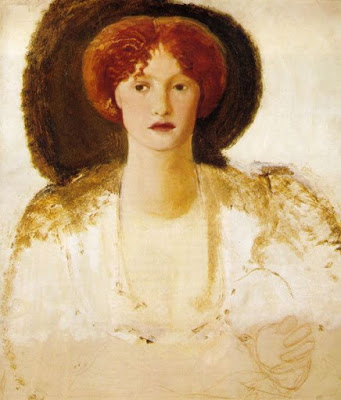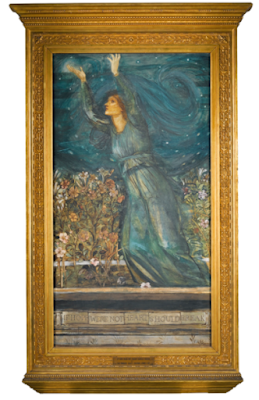Recently I was discussing next year's Burne-Jones exhibition at the Tate on Facebook and I said I hoped that they would talk about Fanny Cornforth. It's not that I'm Fanny obsessed (okay, my life is almost entirely Fanny-centric), but I have always been fascinated how Fanny and Ned got together in the first place. In this post I wrote a few years back, I talked about how Ned and Fanny have always been one of art's odd couples because they didn't seem to match, aesthetically speaking. Then again, I have always loved this picture...
 |
| Hope (1862) Edward Burne-Jones |
It is one of Burne-Jones' most lovely, if unfinished, paintings, and I have always regretted we couldn't see the rest of the image. What was the vision of her? What made Fanny personify 'Hope' for the artist and what did that vision entail? Come to think of it, Burne-Jones spent a lot of time thinking about hope. What was Burne-Jones hoping for?
 |
| If Hope Were Not, Heart Should Break (1890s) |
The quote comes either from a Stuart clergyman, Thomas Fuller, or a thirteenth century proverb, but the meaning is obvious - don't give up, things will get better etc etc, but also possibly more than that. Hope is essential for living, it is hope that keeps us going. It is an acknowledgement of the power of nil desperandum. I began to wonder if there was a connection between the images of Hope and the times in which they were painted. Did Burne-Jones acknowledge his need for hope at certain times and the paintings were material manifestations of these feelings, or was it just a subject he liked? And what does all that have to do with an unfinished painting of Fanny Cornforth?
 |
| Hope (1896) |
This Hope (1896) was painted towards the end of Burne-Jones' life, and was commissioned by Mrs George Marston Whitin of Whitinsville, Massachusetts. She wanted dancing girls but the artist needed Hope. His best friend, William Morris, had just died and that had dealt a severe blow to him and his work. He offered Mrs George Marston Whitin a painting of a figure reaching up to the heavens, despite the bars that obscure her view. It was at this point he needed to reach up, despite being shackled to the sadness of life.
 |
| Windows at St Margaret's Church, Hopton-on-Sea |
The 1896 oil painting was a copy of an early watercolour from 1871, which had served as a draft for a stained glass window. 1871 was during a personally disastrous period for the artist and his family, much of which was self-inflicted. In Georgiana Burne-Jones' diary the period 1868-71 are simply recorded as 'Heart, thou and I here, sad and alone', as her husband conducted a destructive affair with Maria Zambaco. Even though the climax of the affair had been in 1869, with the attempted suicide of Zambaco in the street while Burne-Jones clung to her, Zambaco's image haunted the artist's work and no doubt caused much tension and pain within the marriage. No wonder Burne-Jones needed some optimism that it would all blow over.
 |
| Spes, Hope in Prison (1874) |
However, the 1870s were not kind to Burne-Jones. The fact he felt the need to do another version of Hope (although some argue that this one was painted mostly by his studio assistants) may indicate that the need for Hope during a period of 'imprisonment' within a situation. As we covered in this post, the critics were unkind to Burne-Jones for many reasons in the 1870s and while recovering his personal life, his professional life was under attack. He obviously needed intervention by Spes, the Goddess of Hope. So, returning to the first picture, what 'hope' did Burne-Jones need in 1861? His son Philip had been born, he was doing well, his friends were all married and expecting children and the firm of Morris, Marshall, Faulkner & Co had opened for business. No doubt he was busy but it doesn't exactly sound like desperate times. Then again, maybe it wasn't him who needed hope...
 |
| Merlin and Nimue (1861) Edward Burne-Jones |
When Rossetti married Elizabeth Siddal in 1860, he allegedly swore off all models except his beautiful wife. This was a terrible blow to Fanny Cornforth, who had been living a jolly life as his mistress and muse. In George Price Boyce's diary we are left in no doubt how seriously Fanny took her relationship with Rossetti - she worried about how Rossetti perceived the time she spent with Boyce and she became bedridden with grief when Rossetti married Elizabeth. She had lost her lover and her income at one fell swoop, but oddly it was Burne-Jones who provided her with work, using her as the beautiful but shifty Nimue and a firey-orange-clad Venus in Laus Veneris. He also started the abandoned oil entitled Hope, possibly because by the time he worked on it, Mrs Rossetti had died and Fanny had been reunited with her erstwhile and damaged beloved. She was definitely in need of hope, in need of the reassurance that all would get better, but aside from the whistful face, very little else of the oil painting was clear, and I had always wondered what the finished picture was going to look like.
 |
| Bocca Baciata (1859) Dante Gabriel Rossetti |
Rewinding back a few years to the high-days of Fanny and Rossetti (and Boyce)'s affair, the painting Bocca Baciata had encompassed all the sexual freedom that their lives had consisted of. Fanny was loved by these two men who found her beautiful and untainted by their physical devotion to her. She is temptation, as shown by the apple; she is luxury, expressed by the jewellery and the glorious expanse of hair. I have wondered over her expression in the past, as she looks slightly distracted as if she is aware that her time in the spotlight is finite. The marigold she holds is a member of the calendula family, meaning 'little clock' possibly indicating the passing of time, emphasized by the butterfly on the apple. Maybe there is a case for changing the famous poem to 'Gather ye marigolds while you can...'
 |
| Viridis of Milan (1861) |
In many ways, it is unsurprising that when Burne-Jones came to use Fanny as a model he envisaged her in similar ways as his friend had done. Fanny provided a nice counterpoint to his angelic images of Georgiana from this time, and there are shades of slight threat to paintings such as Viridis of Milan, where she portrays a woman from history, whose father was so bad the Pope preached a crusade against him. Maybe that explains Viridis' 'what's he done now?' expression...
Anyway, it's not a big leap from Bocca Baciata to Viridis of Milan and then to this gouache painting of Hope...
 |
| Hope (1861-2) |
 |
| Hope (1862) |
Seen together these canvases are obviously related and the rest of the unfinished oil can be transposed across from the gouache. In her hand she holds an orb with the inscription 'If hope were not, heart should break', and the dark jacket revealing the white underclothes beneath seems to be inspired by Bocca Baciata. Unlike some of Burne-Jones' other images of Fanny, there seems to be kindness here, a sympathy for her situation where she was truly helpless. All the threat of power that exist in his other images of her is absent and Fanny is just a woman literally holding onto hope and waiting. Unlike his later figures of Hope, Fanny doesn't reach up, or seem to be imprisoned, she just sits there with her little handful of hope, waiting for the call from her beloved.
Maybe the reason Burne-Jones never finished the oil is because the call came, but at another's expense.
Very interesting. I have been reading a book by Josceline Dimbleby about her great grandmother who had an emotional if probably not physical affair with Burne Jones during the last 5 years of his life. The letters are so intense and passionate - it seems that B-J had a tendency to fall in love throughout his life. It's a pity he could not have focused his emotions more on his wife, who seems to have been a good sort, and as you say, was isolated and lonely. B-J always strikes me in photographs as looking unhappy, even tortured. What was he hoping for? Did 'hope' bring him any comfort?
ReplyDelete